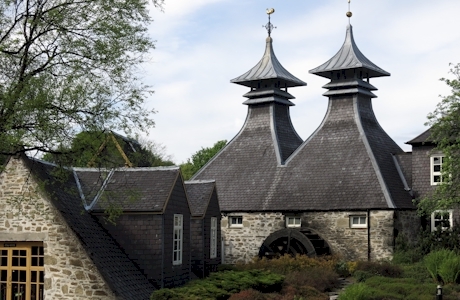UISGE BEATHA: THE WATER OF LIFE
An elderly Scottish gentleman sitting in a pub was asked about the enjoyment of scotch whisky. He replied, “Moderation, aye sir, moderation is the key. Eight or nine glasses can be a pleasant enough evening, but more than that is liable to degenerate into drinking.”
“Scotch whisky is the essence of Scotland- love and pain, and always, the sea, bound together as poetry in a bottle.”
This is the place where the tar meets the rope, the salt breeze blows through your hair, and peat, smoke, and heather call out your name. So, if you are ready to take a journey through Scotch Whisky, the gift of Scotland, then pour a dram, take a sip, and say: Slainte!
SO, WHAT IS “SCOTCH WHISKY?”
First, we need to define the term “whisky” (a.k.a. whiskey, depending on where it’s made. More on that below**). Whisky is any type of distilled alcoholic beverage made from fermented grain mash. Various grains are used for creating different varieties of whisky. The most commonly used are barley, corn, rye, and wheat. Most whisky is aged in wooden barrels, although modern distillers regularly experiment with different aging techniques. The four most common classes of whisky (whiskey) are Scotch, Irish, Bourbon, and Canadian.
“Scotch” whisky (or simply “Scotch”) is distilled in accordance with strict Scottish production and labelling laws. Although Scotch was originally made from malted barley, distillers began introducing whisky made from wheat and rye in the late 19th century. Malting is the process of germinating grain seeds, then halting germination through heat drying. This is a similar process use by beer brewers and results in an increase in enzymes, starch and sugar, enhancing fermentation and imparting complex flavors to the finished product.
Scotch whisky is divided into five distinct categories: single malt (one single strain of malted barley), single grain (one single strain of grain other than barley), blended malt (a blend of single malt Scotches- also called “vatted malt” or “pure malt”), blended grain (a blend of single grain Scotches), and blended Scotch whisky (a mixture of single malt and grain Scotches). Each of these styles produces slightly differing flavor patterns and intensities, and are generally priced according to the type. Blended Scotch tends to be less expensive, and less “intense,” so are usually a safe bet for introducing Scotch. However, there are many outstanding blended Scotches out there, some quite costly! It’s worthwhile trying many different types of Scotch to learn which you prefer.
To bear the name “Scotch,” a whisky must be made in Scotland and aged for a minimum of three years in oak barrels. Additionally, Scotch much have a minimum bottling strength of 40% alcohol by volume. Since most Scotches vary in strength right out of distillation, many are cut with quality water to achieve a 40% alcohol level. A Scotch bottled at the same strength at which it was distilled is called “cask strength.”
Some Scotch has an age statement on the bottle (expressed numerically), reflecting the years spent in cask aging. Generally, the longer time spent in aging, the smoother and more complex the flavors. Any age statement must reflect the cask age of the youngest whisky used in that Scotch. If there is no age statement, then every whisky contained in the bottle must meet the 3-year aging requirement. That’s why most blends don’t state an age- even if they include well-aged malts, it’s the youngest Scotch in the blend that determines the “legal” age. If a blend does have an age statement, then the age statement represents the youngest Scotch in the blend.
This basic overview of what makes whisky “Scotch” just scratches the surface of the variety and depth of the offerings available. Keep an eye out for additional articles discussing regions, casking, flavor groupings, classic styles and flavors, and so much more!
** WHISKY vs. WHISKEY:
There has been a long raging debate on which spelling is correct. In truth, they both are used interchangeably, but sadly, incorrectly. The difference was born of the translation of the original Scottish and Irish words for each of their respective spirits.
The original Scottish “uisge beatha” was bastardized into the word “whisky” (no “e”), while the Irish “uisce beatha” was bastardized into “whiskey.” Eventually, the Irish brought “whiskey” to America, and the American’s stole the word. So, if it’s Scotch, it’s ‘whisky,” and if its Irish, American (bourbon), or Canadian, it’s “whiskey!”
PS- NEVER CALL SCOTCH WHISKY “WHISKEY” OR YOU WILL BE DRUMMED OUT OF THE SCOTCH DRINKER’S CLUB FOREVER!

